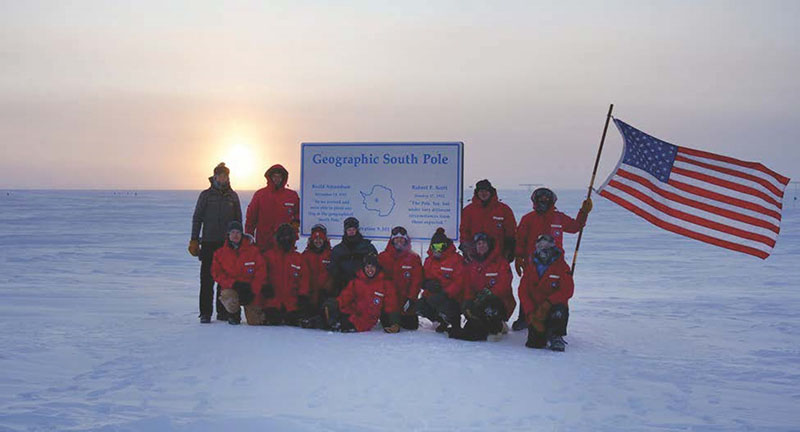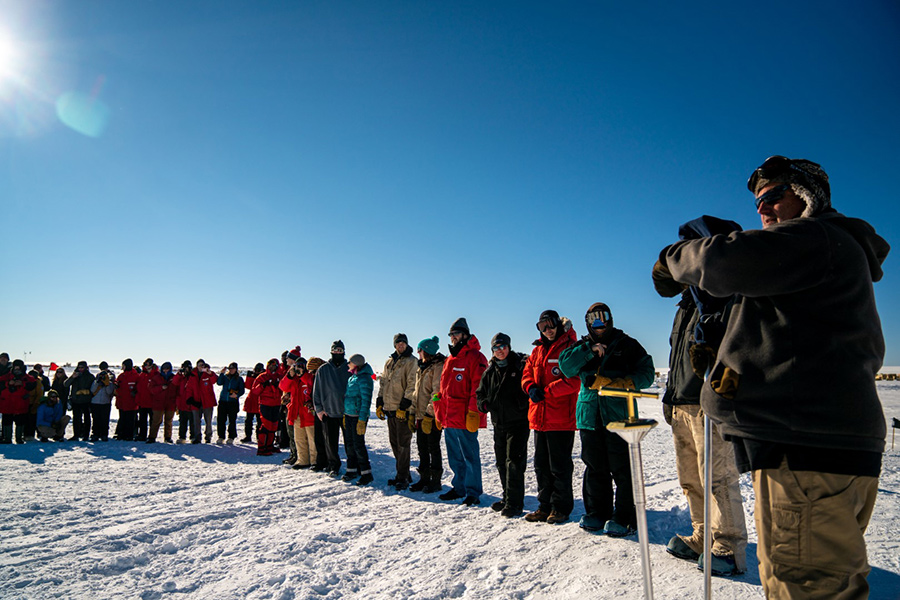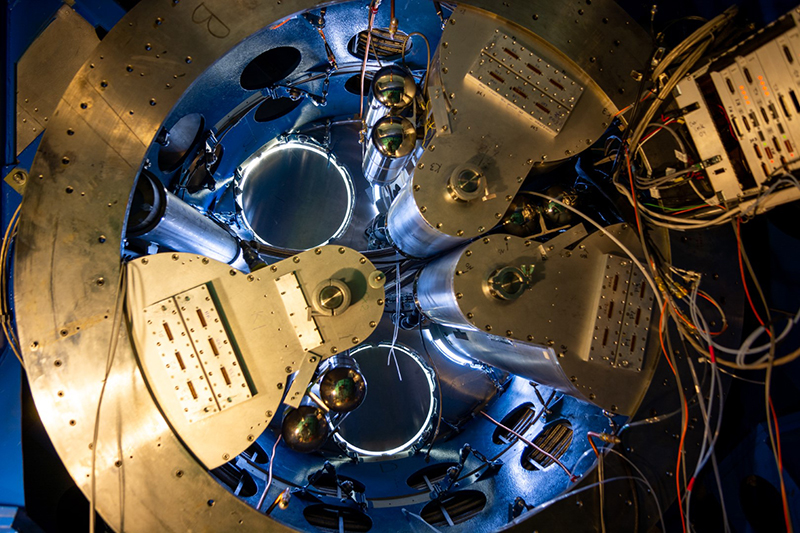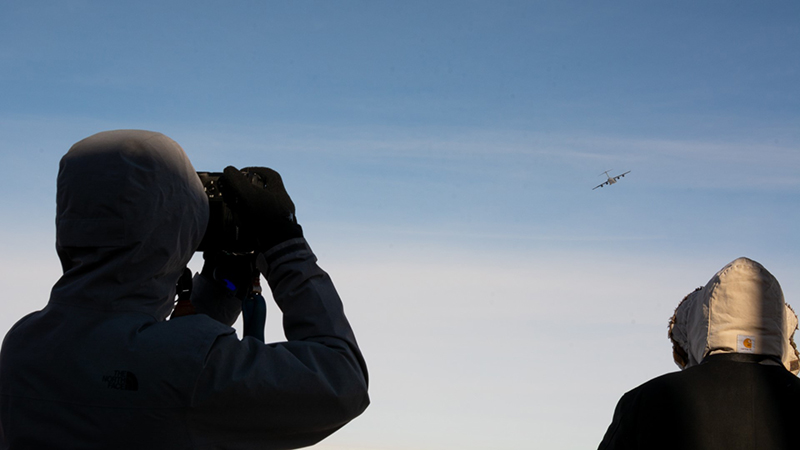|
South Pole Station Archives - 2020
Sunset and Season's EndApril 6, 2020
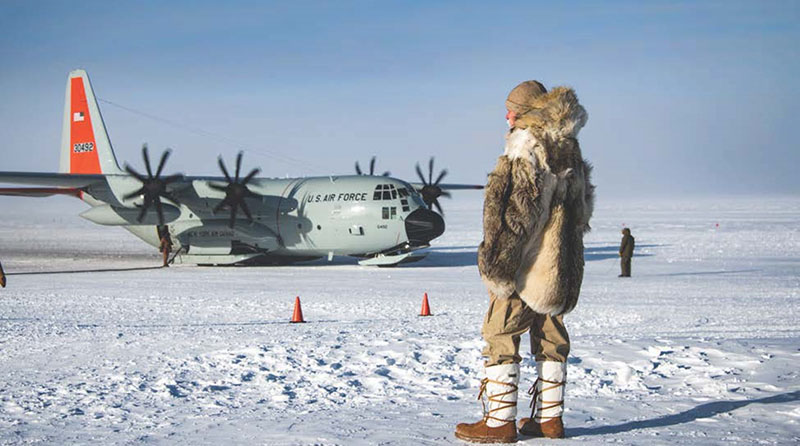
Photo Credit: Yuya Makino
Station manager, Wayne White, dressed in his reproduction Roald Amundsen gear, sees off the last LC-130 of the season.
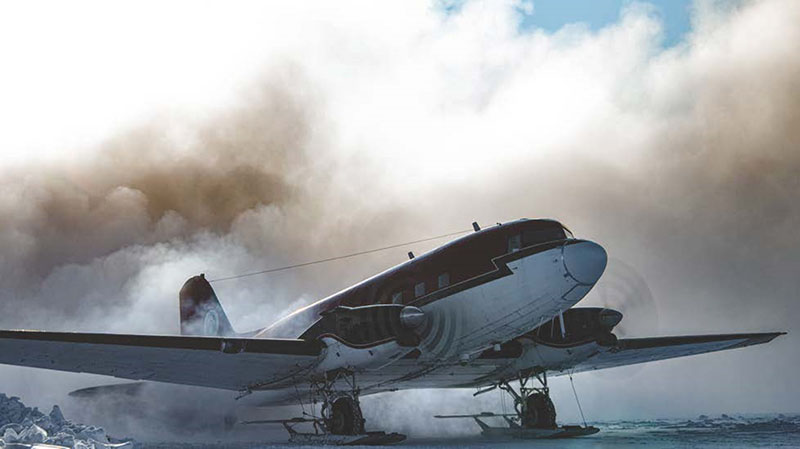
Photo Credit: Yuya Makino
The season's last Basler, a modified DC-3, departs from the South Pole station on route heading north to Canada through Britain’s Rothera station and South America.
February was the month when Amundsen-Scott South Pole station switched over to winter mode —station residents prepared for the last of the summer crew to depart, the last plane to leave and organizing logistics for winter. When the last LC-130 Hercules aircraft left for the season on February 14, it took with it the last of the summer crew. That included those whose primary responsibility is for fueling and defueling planes, the Antarctic Rescue and Fire Department of the South Pole, much of station management and much of the other folks required for summer operation only. But we're prepared; those staying for the nine-month winter received intensive fire emergency response training to fill this role during the winter. Althovugh those "Fuelies," boarded the last plane, a few aircraft still stop through the South Pole on their way off the continent. These are operated by Kenn Borek Air out of Calgary, Canada, and fly through the South Pole on their way to the British Rothera Station on the Antarctic Peninsula before heading up to Punta Arenas, Chile and on to North America. They stop for fuel, and it's up to winter volunteers who have been trained over the summer to operate the fuel systems, conduct recirculation and samples per Air Force specifications, and provide fuel to the KBA pilots. Once all of the last of the KBA planes passed through, the winter crew worked together to take down the fuel pumphouse and put it in storage for winter. If the fuel pump house was left out in its spot, upwind from the station, it'd likely be drifted over by more than ten feet by the end of winter! Several other winter crew took over mission-critical roles for the closing of the station. Wayne Yahnke, our IT administrator, took over the communications control room, contacting the KBA pilots as they approached, turning on the crossing beacon, and ensuring no one was on the skiway when they were ready to land. The winter fire response team trained on how to respond to an aircraft fire emergency for the very last LC-130, including driving a tractor with a trailer containing several hundred gallons of freeze-resistant firefighting foam. Once the station was successfully ready for the season, the winter manager, Wayne White, held the first winter all-hands meeting, where we all saw the final crew of all 42 of us. While many of us had gone through team-building at Estes Park, Colorado, and spent some of the summer together, there were a few of us that joined the crew as late as the last weekend. Wayne warned of common winter mishaps and encouraged us to truly get to know each other personally so that when the going gets tough, we can see if someone's not doing well and show compassion. We also set up the gym for the traditional annual screening of "The Thing" the evening station closes—and not just one, but all three versions, all in a row! Suffice to say, Antarctic horror films, while enjoyable for some, were quite the experience to be endured by others. The gathering marked the first group event on station, and the crew was thrilled to partake in the first true winter event together. This past weekend, we celebrated the annual Sunset Dinner to mark the last days of sun for the next six months. The kitchen staff once again really outshone themselves, serving Bahn Mi and various cheese plates as hors d'oeuvres during a cocktail reception preceding the seated dinner. The sun was positioned at roughly 3 o'clock in the sky, relative to the station, so it shone brilliant hues of gold and orange through the windows. We were quite lucky to get such a sunset display—the preceding week had been totally overcast and there were doubts as to whether or not we would see the sun again before the end of winter! Volunteer servers bused each course of the meal out, and Wayne White gave a heartwarming toast to the start of winter and to "the 2020 crew, the only 2020 winter crew there will ever be." He noted that while we may be isolated from the effects of the pandemic sweeping across the world, he wanted us to know that it could still be hard on members of our crew worrying about loved ones, and that we always have someone to talk to if we need. The whole evening felt surreal—the food was fantastic, the sun came out, and pretty much the entire winter crew came out for the occasion. The evening ended with cheery Polies taking several last photos of the sunset and then all gathering in the gym for a movie night. Polar HolidaysJanuary 21, 2020
December at the South Pole was filled with exciting projects and plenty of festivities in preparation for the holidays. Over the span of several weeks, a number of Polies participated in small field expeditions to remote sites accessible only from Pole. They helped recover the fuel caches that were dropped near AGAP South sites in support of ice sheet science earlier this season, as well as the retrieval of NASA's Long Duration Balloon X-Calibur that was launched in 2018. Spending a full day in the field, requires the teams to attend field safety training prior. After the required training, a two-hour flight on a Kenn Borek Air Twin Otter plane brought Polies about 300 miles away to the fuel-drop site, where parachutes were recovered, and fuel drums dug out of the snow. It was hard work, but the remote trip was a treat to many of those who don't regularly get to leave the station. The station also pitched in to help prepare for the 88-South Traverse, a caravan of PistenBullies and sleds carrying camping and GPS instrumentation following the 88-degree South latitude line around the Pole. Their objective is to collect highly precise elevation data to compare to ICESat-2 elevation data. There was also snow science to be done. Accumulating snow drifts require that several of the scientific outbuildings will need to be raised within the next few years. This involves jacking the buildings up, laying down layers of snow beneath them, allowing for the snow to compact to sufficient strength and setting the buildings down again. With limited independent data on snowpack compaction, support staff at the station carried out some of their own experiments to see what might work best. They looked at different methods of working snow (bulldozed, snow-blown, or undisturbed), time elapsed and analyzed different depths of layers. Using the Snow Beast (a large snowblower) and bulldozers to work the snow into different height hills, ice cores were then collected to measure densities over the span of a few days. The station's greenhouse is also officially up and running. Carbon-dioxide emitters and ultraviolet lights have been turned on for the season, and the sprouts are being transported to their hydroponic growth chambers. The station just performed its first harvest—bok choy and mizuna for fresh greens on Burger Day. In preparation for the holidays, station residents enjoyed the annual gingerbread house contest. A gingerbread version of the station won the competition and was placed as the Christmas Dinner dessert table centerpiece. Just as it had for Thanksgiving, the Pole community gathered on Christmas Eve to prepare the galley for the special dinner, and the Galley staff went all out for the Christmas meal. On Christmas Day, the annual Race-Around-the-World fun-run; participants ran a two-mile race that looped around the Geographic South Pole. Afterwards, several Polies participated in Secret Santa, a gift exchange where gift givers were forced to get creative with hand-made presents, as shopping isn't an option. January 1, 2020, saw the traditional relocation of the Geographic Pole Marker to the new correct position. The ice sheet the station is built on shifts about 30 feet a year, meaning that the pole marker has to be moved to the geographically accurate location each year. The winter crew designs and fabricates the new marker, keeping its final form a secret until it's unveiled on New Year's Day. During the month of December, surveyors map out the new correct position. Finally, at the ceremony itself, each station member passes the pole marker down the line in a spiral towards the pole, where it is placed for the next year. The Season Starts UpJanuary 8, 2020
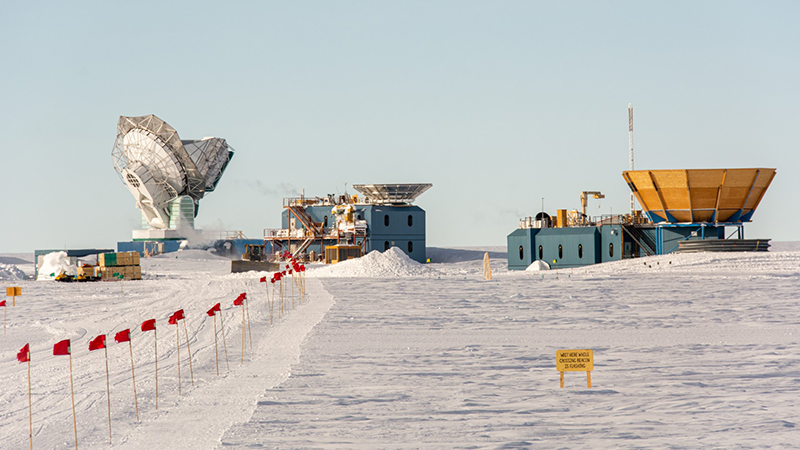
Photo Credit: Mike Lucibella
The telescopes of the South Pole: (Left to right) The South Pole Telescope, BICEP3 and the Keck Array, soon to be the new BICEP Array.
The summer season has kicked off and is now in full swing—the month of November seemed to fly by. Time seems to work differently at the South Pole. On the one hand, time seems to pass quickly and the amount of new experiences and the number of different things going on seems like it can't possibly fit in the time that's elapsed. At the same time, though only a month has passed, it can feel like ages to Polies, in the best of ways. Due to some initial flight delays, there was a bit of a slow start to the season, with many of the larger projects such as BICEP and IceCube waiting on science cargo to arrive. But by the end of November, the cargo finally made it to Pole, and the BICEP folks are hard at work tearing down the former Keck Array and building its successor, the BICEP Array, which is intended to be operational in time for winter. The Pole just celebrated Thanksgiving last week as well. A yearly tradition, the community comes together to decorate the galley as the kitchen staff are hard at work on the Thanksgiving meal. The room was dimmed by closing the windows and festive lights were draped above the tables for a warm, holiday ambiance. This is the first meal of the season where Polies typically dress up, and the tables are adorned with tablecloths and fall decor. Spiced apple cider and hors d'oeuvres were served as diners waited to be seated. The kitchen staff did a phenomenal job with Thanksgiving dinner and desserts, and spirits were high throughout the first two-day weekend the Polies enjoyed. The following week, the South Pole Traverse arrived. The station receives most of the fuel it uses for the year from the traverse. Arriving in a train of Challenger tractors towing fuel bladders and shipping containers housing the living and eating quarters for the crew, it was a sight to behold. The crew had been traveling for about three weeks, and they held an open house of their setup during one of the weekends to show Polies how they lived, worked and ate on the long road from McMurdo. As thanks to the kitchen staff for the work they put into Thanksgiving, the Polies participate in Community Cook Day to give the galley staff a full day off. Each department is assigned to one of the three meals throughout the day, and Polies took part in the demanding work feeding the station for a day. Although the menu items were rather simple, grilled cheese with tomato soup for lunch and pizza for dinner, there was a unanimous feeling of gratitude amongst the Polies now having understood what goes into feeding nearly 150 people every day. Sprinkled throughout the month have been a number of science lectures, detailing the exciting new upgrades coming up for IceCube and describing what goes on behind the scenes to operate and upgrade the South Pole Telescope and BICEP. As the state-of-the-art technology in imaging the Cosmic Microwave Background (CMB) matures and a thorough understanding of the temperature map of the universe develops, scientists at the frontier of the field of CMB research will continue the search for any signal in light polarization that could offer up evidence about the inflation in the very early universe. |
Home /
Around the Continent /
South Pole Station Archives - 2020
"News about the USAP, the Ice, and the People"



For USAP Participants |
For The Public |
For Researchers and EducatorsContact UsU.S. National Science FoundationOffice of Polar Programs Geosciences Directorate 2415 Eisenhower Avenue, Suite W7100 Alexandria, VA 22314 Sign up for the NSF Office of Polar Programs newsletter and events. Feedback Form |


